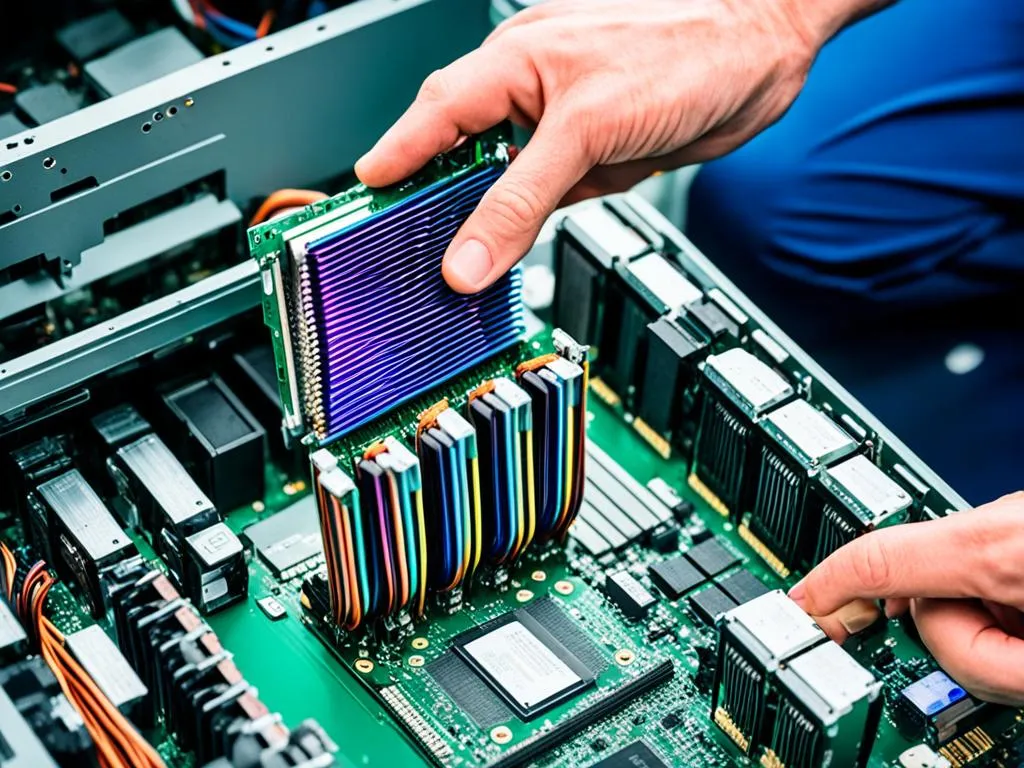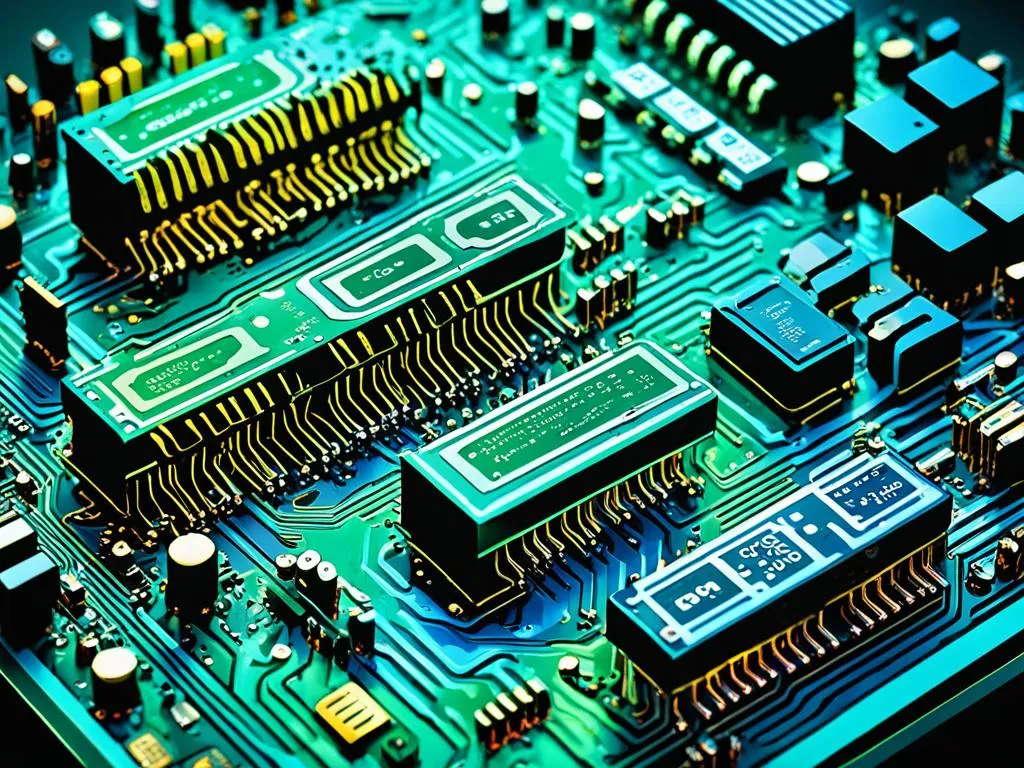Technology keeps getting better, making our electronic gadgets last longer. But, how long does a motherboard, the heart of our computers, really last? Let’s look at what experts say and what affects how long it lives.
Motherboards are key to our computers, holding the important bits like the CPU and RAM. Knowing how long they last helps us decide when to upgrade our devices. So, let’s find out the scoop on motherboard lifespan.
The global Motherboard market was valued at USD 13290 million in 2023. It’s expected to hit USD 14670 million by 2030, a growth rate of 1.4% from 2024 to 2030. Motherboards are in general purpose microcomputers, linking important parts together. Top manufacturers in the world include Asus, Gigabyte Technology, and more.
Table of Contents
ToggleOverview of the Motherboard Market
The global motherboard industry is growing fast. Our research shows that it’s a good time for the sector. It is set to keep growing steadily over the next years.
Market Size and Projections
Our detailed motherboard industry analysis forecasts a rise in the market size. From USD 13,290 million in 2023, it will reach USD 14,670 million by 2030. This is a 1.4% yearly increase during 2024-2030. The reason for this growth is the increasing need for motherboard solutions in different fields, supported by new technologies and government policies.
The motherboard market trends show that industry growth is driven by several key points. These include more advanced tech becoming common, a bigger need for powerful gaming systems, and the growing importance of cloud computing and data centers. With the world getting more connected, demand for reliable motherboards is going up. This points to continuous growth in the industry going forward.
The motherboard market is on the brink of great change. Manufacturers are working hard to meet the changing demands of their clients. Exploring the important players and the industry, we see a lively and competitive environment. Here, innovation and smart strategies are key to being successful.
Key Players and Industry Landscape
The global motherboard market sees fierce competition. A small number of leaders top this industry. These leading manufacturers and experts are changing the motherboard market.
Major contestants in this field are Asus, Gigabyte Technology, and more. They aim to keep their competitive edge through strategic moves. This includes partnerships, mergers, and acquisitions.
This market is open, with key players aiming for more. Their focus is on innovation, better products, and a great user experience. They are also looking at new trends.
| Top Motherboard Manufacturers | Market Share (2021) |
|---|---|
| Asus | 25.1% |
| Gigabyte Technology | 19.8% |
| Micro-Star International Co., Ltd | 16.5% |
| ASRock | 12.6% |
| Others | 26.0% |
As we move ahead, these top manufacturers will lead the way. They will continue to shape the motherboard landscape. They are the ones to watch.
Types of Motherboards and Their Longevity
The motherboard is like a computer’s backbone. It’s very important for the device’s life. Motherboards come in four main types: PC, mobile PC, server, and gaming motherboards.
Server Motherboards
Server motherboards are for big business needs. They are made to last longer than regular PC ones. They have better safety features and use power more efficiently.
Server motherboards make up about 45% of the motherboard market. They are key for running big tasks without stopping, like in data centers. Their long life is vital for these systems to work well all the time.
They have extra features that make them last longer, like:
- Stronger power systems
- Better cooling
- Durable components
- More advanced problem-spotting
These extras, along with ideal working conditions, help server motherboards last longer and stay reliable. As big computing needs grow, the role of durable server motherboards will keep getting more important.
Factors Affecting Motherboard Lifespan
Several key factors affect how long a motherboard lasts. This part is vital for a computer’s performance and reliability. We will discuss the main things that affect how long a motherboard works well.
The quality of a motherboard’s parts is a big deal. Motherboards made with strong materials last longer, up to 7 years. But boards made with cheaper materials may wear out faster, possibly in 2-3 years.
Where you keep your computer matters a lot. If it’s too hot or dusty, the motherboard can be stressed. Such conditions can lead to parts failing earlier. Making sure your computer stays cool and clean can help your motherboard live longer.
How you use and care for your computer are also important. Trying to get more speed by overclocking can harm the motherboard. Likewise, not keeping your computer free of dust can cause problems. You need to be smart about how you use and look after your system.
Knowing about motherboard life expectancy, factors influencing motherboard lifespan, and motherboard durability helps us take better care of our computers. This way, we enjoy using them for a longer time without trouble.
To sum up, a motherboard’s life can be optimized by considering these key elements:
- Quality of the motherboard’s components
- Environmental conditions, such as temperature, humidity, and dust exposure
- Usage patterns, including overclocking and maintenance practices
By keeping these factors in mind and looking after our motherboards well, we can make our computing experience last longer. This approach makes our computers more dependable and enjoyable for a greater time.
How Long Does Motherboard Last: Expert Insights
Industry experts say a high-quality motherboard usually works well for 5-7 years with normal use. Yet, some last even longer. The true motherboard longevity depends on how it’s used and the environment it’s in.
If you’re using a motherboard for big jobs, like in servers, it can do well for 7-10 years. This longer life is possible with good care. Specialized motherboard designs are often very tough and go through strict quality checks.
It’s smart to keep an eye on how your system is working. If something seems off, it’s wise to act fast. Doing regular updates and keeping things clean can give your motherboard a longer life. It also makes sure your whole system stays reliable.
| Motherboard Type | Average Lifespan |
|---|---|
| Standard Desktop Motherboard | 5-7 years |
| Server Motherboard | 7-10 years |
| Industrial/Embedded Motherboard | 7-10 years |
Learning about typical average lifespan of motherboards and what affects it is important. This way, you can decide smartly on replacing your motherboard when it’s time. Knowing this helps keep your computer running well for years.
Signs of a Failing Motherboard
The motherboard is like the heart of a computer, linking all its parts together. Over time, motherboards can wear out and cause problems. It’s key to spot early signs of trouble to fix them fast and prolong our devices’ life.
One common sign of a failing motherboard is the Blue Screen of Death (BSOD). If your computer crashes suddenly and shows a strange error message, your motherboard might be to blame. System freezes or reboots without reason can also mean there’s a problem.
Trouble starting up, like a slow boot or not starting at all, could point to a failing motherboard. If your computer can’t talk to things like the keyboard or mouse, the motherboard might be faulty. These are more hints to watch for.
If your computer is slow without reason, it could be another sign of a problem. These issues might seem small at first, but they could get worse. Paying attention to them can help avoid bigger headaches later.
Being aware of these signs can help you keep your computer working longer. It’s important to do regular checks and notice any strange behavior. This will make your computer more dependable over time.
| Symptom | Description |
|---|---|
| Blue Screen of Death (BSOD) | Unexpected system crashes with cryptic error messages |
| Random system freezes or reboots | Intermittent system stability issues |
| Booting problems | Slow or failed system startup |
| Peripheral connectivity issues | Inability to recognize or communicate with external devices |
| Performance degradation | Slower response times, lagging, or unexpected system slowdowns |
Extending the Life of Your Motherboard
Your motherboard is like the heart of your computer. It’s key to how well your device performs and how long it lasts. A few motherboard maintenance tips can make a big difference. They help improve motherboard lifespan and prolong motherboard usage.
Cooling your motherboard properly is a must. Make sure your computer’s cooling works well. Plus, think about upgrading to better cooling if needed.
Overclocking can harm your motherboard. It’s best not to do this unless you know what you’re doing.
Keeping your motherboard clean is also crucial. Use a soft, dry cloth to gently remove any dust or dirt. Never use liquids or cleaning solutions, as these can damage it.
It’s important to have a reliable power supply for your motherboard. Your power supply unit (PSU) should give your system steady power. If you see any power problems, it might be time for a new PSU.
Always follow the maker’s advice for using and caring for your motherboard. This means keeping to the right temperature, avoiding too much stress, and using correct hardware and software.
Following these motherboard maintenance tips improves your motherboard’s life. It helps your computer run better for longer.
When to Replace Your Motherboard
A well-kept motherboard will work for many years. Yet, at some point, upgrading or changing it might be necessary. This need often arises from the introduction of new, better chipsets or from not being able to handle new hardware.
Also, if your system faces ongoing performance problems, it’s a sign to check your motherboard. For those into tech, checking your system’s needs and your motherboard’s health is crucial.
Signs It’s Time to Replace Your Motherboard
Knowing when your motherboard is almost done can guide your next steps. Look for these clues:
- Inability to support the latest processors or other hardware components
- Frequent system crashes, freezes, or other unexplained performance issues
- Compatibility problems with new software or driver updates
- Limited connectivity options or outdated ports and interfaces
- Overheating issues or physical damage to the motherboard
Motherboard Replacement Guidelines
Changing your motherboard means considering several things for a smooth shift. Here’s what you need to remember:
- Pick a new motherboard that fits your system. Ensure it matches in chipset, size, and features.
- Backup your data and have a plan for setting up your system and apps again. A new motherboard often needs a fresh start.
- When changing motherboards, handle the switch carefully. Always guard against static.
- Update your BIOS or UEFI to the newest version. This helps your new motherboard and other parts work smoothly together.
- After the change, test everything. Make sure your system works well before you resume normal use.
Watching for signs of a weakening motherboard and changing it the right way keeps your system in top shape. This approach helps your computer run well for years.

Conclusion
In conclusion, Motherboards are key to our computer systems. Their lasting power is vital for how well our devices work and their dependability. A good Motherboard might work well for 5-7 years or more if used normally. Yet, the actual time it lasts is affected by many things. These include the quality of parts, the environment it’s in, and how well it’s taken care of.
Knowing about Motherboard life helps us keep our systems running well for a long time. Signs that your Motherboard is failing and how to maintain Motherboards are crucial. By regularly cleaning, keeping them cool, and updating them on time, we can use our Motherboards longer. This also helps get more value from the money we spend on our computers.
In short, the lifespan of a Motherboard shows why choosing and taking care of computer parts wisely is so important. When we choose good quality and follow recommended care, we benefit. This way, our computers work without trouble, and we avoid the high cost of sudden Motherboard breakdowns.
FAQ
What is the current size and projected growth of the global Motherboard market?
In 2023, the global Motherboard market was valued at USD 13290 million. By 2030, it’s expected to grow to USD 14670 million. This means it will grow by 1.4% every year from 2024 to 2030.
Who are the key Motherboard manufacturers leading the global market?
Leading the global market are manufacturers like Asus, Gigabyte Technology, Super Micro, Micro-Star International Co., Ltd, and Advantech.
How can Motherboard lifespan be influenced by various factors?
Many things affect how long a Motherboard lasts. These include the quality of its parts, the environment it’s in, how you use it, and if you take care of it.
What is the typical lifespan of a well-maintained Motherboard?
A well-kept Motherboard can last 5-7 years or more. This is if you use it normally and take care of it well.
What are the common signs of a failing Motherboard?
Signs of a failing Motherboard include system crashes, BSOD errors, trouble starting up, problems connecting devices, and slow performance for no clear reason.
How can users extend the lifespan of their Motherboard?
You can make your Motherboard last longer by doing a few key things. Keep it cool, don’t overclock, clean it often, and make sure it’s not covered in dust. Also, a stable power supply is vital.
When is the optimal time to replace a Motherboard?
If your Motherboard can’t handle new hardware or keeps having problems, it might need replacing. Pay attention to what your system needs and how your Motherboard is performing to know when it’s time for a new one.

















